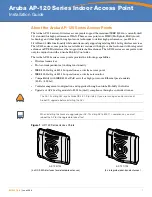
Aruba AP-120 Series Indoor Access Point
Installation Guide
0510457-06
| June 2008
1
About the Aruba AP-120 Series Access Points
The Aruba AP-120 series of wireless access points support the imminent IEEE 802.11n (currently draft
2.0) standard for high-performance WLAN. These access points use MIMO (Multiple-in, Multiple-out)
technology and other high-throughput mode techniques to deliver high-performance, pre-802.11n
2.4 GHz and 5 GHz functionality while simultaneously supporting existing 802.11a/b/g wireless services.
The AP-120 series access points are available in versions with single or dual radios and with integrated
antennas or RP-SMA interfaces that support detachable antennas. The AP-120 series access points work
only in conjunction with an Aruba Mobility Controller.
The Aruba AP-120 series access points provide the following capabilities:
z
Wireless transceiver
z
Protocol-independent networking functionality
z
IEEE 802.11a/b/g or 802.11n operation as a wireless access point
z
IEEE 802.11a/b/g or 802.11n operation as a wireless air monitor
z
Compatibility with IEEE 802.3af PoE as well as high power over Ethernet pre-standards
(PoE + / 802.3at)
z
Central management configuration and upgrades through an Aruba Mobility Controller
z
Upgrade of AP-12x a/b/g models to 802.11n (draft) compliance through a controller license
Figure 1
AP-120 Series Access Points
!
CAUTION
The AP-12x a/b/g APs
require
ArubaOS 3.3.1.9 (or later). If you are running an earlier version of
ArubaOS, upgrade before installing the APs.
N O T E
When installing the license to upgrade your AP-12x a/b/g AP to 802.11n compliance, you must
reboot the AP for the upgrade to take effect.
ap12_001
AP-120/124
(3 x RP-SMA interfaces for detachable antennas)
AP-121/125
(3 x integrated dual-band antennas)












